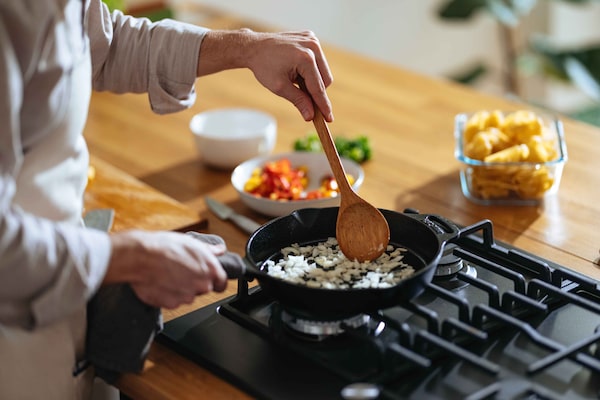
Frying pans are among the most essential tools in the kitchen, so it's important to have the right pan for you needs.miniseries/iStockPhoto / Getty Images
Frying pans are kitchen workhorses, and it is essential to get the right ones.
In my experience, versatility is key, so don’t buy a “set” of pans – you won’t use half of them, and it’s better to have a mix of non-stick and regular, which you won’t get in most sets. Instead, customize your collection to meet your personal preferences.
If you love stir frys and sautés, you may need more than one frypan. If pasta is your go-to, make sure you have one pot for boiling noodles and one for sauce. If crepes are your favourite breakfast, make sure you have a small non-stick crepe pan in the cupboard. If you have an induction stove, stay away from aluminum and copper, which won’t heat on an induction element.
What you need to know about non-stick pans
These pans make cooking any kind of eggs, crepes or pancakes a cinch. They are easy to wash, but can’t be used on high heat, as it will eventually damage the coating. The best purchase is one eight-inch frying pan, along with a 10-inch. Look for pans with flared sides, as omelettes and frittatas will slip out easily.
Don’t use them for making sauces or for caramelizing onions; the coating does not allow the acid and stock to combine into a sauce that will thicken. To dispel a common myth, these pans are no longer made with material that includes the now-banned PFOA, which might cause cancer and was toxic for the environment.
All-Clad, Calphalon and Le Creuset have splurge-worthy non-stick pans and Tramontina is a good non-stick affordable brand that is available at big box stores.
What you need to know about stainless steel pans
Stainless steel on its own is not the best conductor of heat. For even better results, look for pans that have aluminum – an excellent heat conductor – sandwiched between layers of stainless steel. When cooking, always heat the pan first, then add the fat to avoid food sticking. I depend on them to make dishes such as Bolognese sauce, for searing chicken breasts and for sautés.
All-Clad is a most dependable high-end brand liked by restaurant chefs and home cooks. And again, Tramontina is a dependable lower-cost alternative.
What you need to know about cast iron pans
A kitchen mainstay, cast iron is extremely versatile and used in many restaurant kitchens because they are indestructible and inexpensive.
Use one to sear a steak, brown chicken, make the perfect pasta sauce, sauté vegetables, bake bread or pop giant cookies in the oven. It is also perfect on induction.
Lodge cast irons are a good inexpensive choice, while Finex is a high-end excellent pan. You may even find great nameless cast iron pans at garage sales and vintage stores but they will need some love and elbow grease to get them cook-ready. Lots of videos online explain the seasoning process, and many new pans don’t need you to do it at home any more. But they may need to be reseasoned over time by coating with vegetable oil and leaving in a 350 F oven for 45 minutes. They will last much longer if you don’t use a tough scrubber on them. Rinse with soapy water and use a soft cloth.
What you need to know about cast iron enamel pans
These stunning cast iron pans coated with enamel, such as those made by Staub or Le Creuset, do not require seasoning and come in many rich colours, brightening up the kitchen. They’re expensive but they last a lifetime.
The Staub slope-sided daily pan is one of my favourites because of its versatility. It’s useful for everything from a stir fry to a casserole. They all go from stove to oven to table – and they are induction friendly.
If you’re looking to spend less, consider looking at Costco. They often carry less expensive brands such as Tramontina. Also try shopping at discount stores which sell factory seconds, or pans that have minor cosmetic scratches, dents or colour variation, but still provide the same function and performance. Other pans may be available, too.
What you need to know about copper pans
Copper is my favourite cooking material, although it does not work on my new induction stove. It heats evenly, retains it evenly and makes wonderful sauces because of its ability to bind ingredients without scorching them. And they are surprisingly easy to clean, though they are very heavy.
Copper pans look beautiful and last forever, earning a darker patina as they age. I have my mother’s copper pots and they are still perfect after 50 years of regular use. It takes nothing to maintain them except cleaning the copper when they get really black. Viking makes copper pans that are induction safe and Mauviel is an easily sourced brand of good copper pans.
Recipe: Pan-Fried Rib Eye Steak with Cabernet Essence
Serves 4 to 5
Searing a steak in cast iron is a joy, and using the “fond” – the little bits stuck on the pan – to finish the sauce gives huge flavour. If you are looking for a less-expensive steak, try sirloin cap or picanha, which is the fat-topped, long thick piece of meat near the rump. It is very tender and full flavoured, and more commonly available now. Other steaks include flank, hangar or bavette, but rib-eye is the finest.
Steak:
- 2 500 g rib-eye steaks about 1 ½ inches thick
- Kosher salt and freshly ground pepper
Sauce:
- 2 tsp butter
- 1 cup chopped shallots
- 2 cups cabernet sauvignon or other red wine
- 1 bay leaf
- 1 stalk thyme
- 1 cup beef or chicken stock, homemade or store-bought
To cook steak:
- 1 tbsp olive oil
- 2 tbsp unsalted butter
- Garnish
- Maldon salt
- 3 tbsp finely chopped shallots
Liberally salt steak with Kosher salt two hours before using. This acts like brine. Pepper just before cooking.
To make sauce ahead: In stainless steel or cast iron skillet on medium, heat butter and add shallots. Sauté until slightly browned. Add wine, bay leaf and thyme and reduce until 1/4 cup liquid remains. Add stock and reduce until sauce is slightly thickened, about three minutes. Reserve until needed.
Heat oil and butter in heavy cast iron or cast iron enamel skillet on medium-high heat. Add steaks and brown on one side, about 5 minutes, basting occasionally. A grill pan is very good for this. Turn. Cook the second side for 3 to 5 minutes or until medium-rare – 130 F to 135 F on a meat thermometer. Remove from pan and let rest. Discard fat. Add sauce to pan and scrap up any fond and juices. Add additional stock if the sauce is too thick. Slice steaks into 1/4-inch slices. Spoon over sauce. Sprinkle with Maldon salt and finely chopped shallots just before serving.
Need some advice about kitchen life and entertaining? Send your questions to lwaverman@globeandmail.com.
 Lucy Waverman
Lucy Waverman